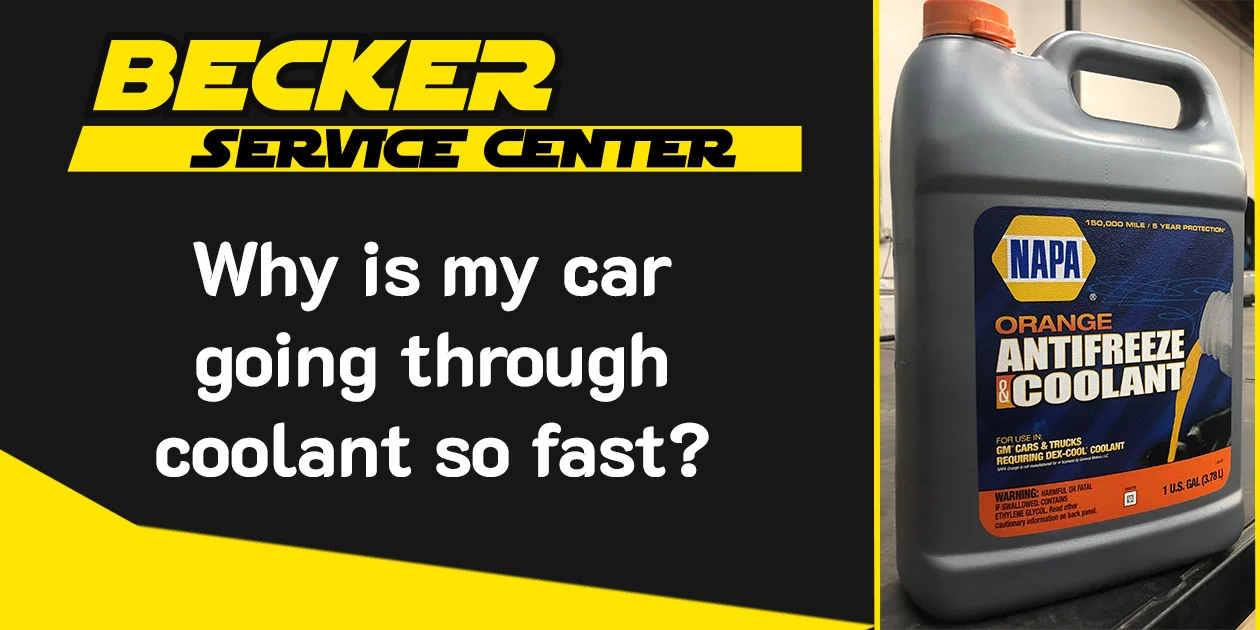Is your car guzzling coolant at an alarming rate? You might be worried.
High coolant consumption can indicate serious issues. Coolant, also known as antifreeze, keeps your engine from overheating. When your car consumes it quickly, it signals a problem. It could be a minor leak, a faulty part, or something more serious.
Regular checks can help identify the issue early. Ignoring it could lead to engine damage and costly repairs. Understanding why your car is using too much coolant can save you time and money. In this blog, we will explore common causes and solutions. Stay with us to keep your car running smoothly and avoid unexpected breakdowns. Let’s dive into the details.
Common Causes Of Coolant Loss
Is your car consuming coolant faster than usual? Understanding the common causes of coolant loss can save you from unexpected breakdowns and expensive repairs. Several issues can lead to rapid coolant loss, each with its own symptoms and solutions.
Leaking Radiator
A leaking radiator is a common culprit behind coolant loss. Radiators can develop leaks due to corrosion, physical damage, or aging. Signs of a leaking radiator include:
- Puddles of coolant under the car
- Visible coolant on the radiator
- Overheating engine
Regular inspections can help spot these issues early. Look for wet spots or rust around the radiator. If you find any, repair or replace the radiator to stop the leak.
Faulty Water Pump
The water pump is crucial for circulating coolant through the engine. A faulty water pump can cause coolant to leak and lead to engine overheating. Symptoms of a failing water pump include:
- Coolant leak at the front-center of your car
- Overheating engine
- Squealing noise from the engine area
Check the water pump for leaks or corrosion. If the pump is damaged, it must be replaced immediately to prevent further coolant loss and engine damage.
Signs Of A Coolant Leak
Your car’s coolant is essential for keeping the engine from overheating. If your car is consuming coolant fast, it could be due to a coolant leak. Recognizing the signs of a coolant leak can help you address the issue early and prevent severe damage.
Puddles Under The Car
One of the most obvious signs of a coolant leak is finding puddles under the car. Coolant is usually green, orange, or pink, so if you see a colorful liquid under your car, it might be coolant. Check the puddle’s location. If it’s near the front of the car, it could be from the radiator or a hose.
Low Coolant Warning Light
Another clear sign is the low coolant warning light on your dashboard. This light indicates that the coolant level is lower than it should be. If this light comes on frequently, it suggests a possible leak. Always pay attention to this warning. Ignoring it can lead to engine overheating.
| Signs | Description |
|---|---|
| Puddles Under the Car | Colorful liquid under the car, usually green, orange, or pink. |
| Low Coolant Warning Light | Dashboard light indicating low coolant level, suggesting a possible leak. |
Pay attention to these signs. They can help you identify a coolant leak early. Early detection is crucial to prevent further damage to your engine.
Radiator Issues
Is your car going through coolant too fast? Radiator issues could be the cause. The radiator plays a key role in your car’s cooling system. If it has problems, your car may lose coolant quickly. Let’s look at some common radiator issues.
Cracked Radiator
A cracked radiator is a frequent problem. Cracks can form from wear and tear. They can also result from extreme temperature changes. A cracked radiator will leak coolant. You might notice puddles under your car. Low coolant levels can cause engine overheating. It’s essential to fix a cracked radiator quickly.
Damaged Radiator Hoses
Radiator hoses carry coolant between the engine and radiator. If these hoses are damaged, coolant can leak out. Hoses can crack, split, or get loose over time. Checking and replacing damaged hoses is vital. This helps maintain proper coolant levels and prevents overheating.

Credit: www.reddit.com
Water Pump Problems
Water pump problems are a common reason why your car uses coolant quickly. The water pump circulates coolant through the engine to prevent it from overheating. If the water pump fails, coolant leaks or doesn’t circulate well. This can cause your car to lose coolant fast.
Worn-out Seals
Seals in the water pump keep coolant from leaking out. Over time, these seals can wear out. When seals fail, coolant leaks from the pump. This leakage reduces the amount of coolant in the system. You might notice puddles of coolant under your car. Check seals regularly to avoid this issue.
Bearing Failure
Bearings in the water pump help the pump rotate smoothly. These bearings can wear out or fail. When bearings fail, the pump may not work well. This can cause coolant to leak or not circulate properly. You might hear a grinding noise from the engine. Regular maintenance can help spot bearing issues early.
Head Gasket Failure
Head gasket failure is a common reason for rapid coolant loss. The head gasket seals the engine block and cylinder head. Its role is crucial in maintaining engine performance. If it fails, it can lead to several issues. These problems can cause your car to use up coolant quickly. Let’s explore some signs of head gasket failure.
Overheating Engine
An overheating engine is a clear sign of head gasket trouble. The head gasket helps control engine temperature. When it fails, the engine can overheat. This happens because coolant leaks and can’t circulate properly. An overheating engine can lead to severe damage. Always monitor your car’s temperature gauge.
White Smoke From Exhaust
White smoke from the exhaust is another symptom. This smoke indicates coolant is burning in the engine. The head gasket failure lets coolant enter the combustion chamber. When coolant burns, it creates white smoke. This can also lead to a sweet smell from the exhaust. If you see this, check your car for other issues too.
Coolant Reservoir Troubles
Is your car going through coolant too quickly? The coolant reservoir is a common culprit. This small tank plays a big role in your car’s cooling system. If the reservoir has issues, your engine might overheat. Let’s dive into some common problems.
Cracks In The Reservoir
Cracks in the coolant reservoir are a major issue. These cracks can cause coolant to leak. A cracked reservoir can’t hold coolant properly.
Look for signs of leakage under your car. If you see puddles, inspect the reservoir. Even small cracks can cause big problems. Replace the reservoir if needed. This simple fix can save you from bigger issues later.
Faulty Reservoir Cap
The reservoir cap is more important than it looks. A faulty cap can’t maintain proper pressure. This can cause coolant to escape as steam.
Inspect the cap for any damage. If it’s not sealing well, replace it. A new cap is inexpensive and easy to install. It can make a big difference in your car’s cooling system.
Let’s summarize the key points about coolant reservoir troubles:
| Issue | Symptom | Solution |
|---|---|---|
| Cracks in Reservoir | Coolant leaks | Replace reservoir |
| Faulty Reservoir Cap | Coolant escapes as steam | Replace cap |
Thermostat Malfunctions
Thermostat malfunctions can cause your car to use up coolant quickly. The thermostat controls the flow of coolant to the engine. If it malfunctions, it can lead to significant issues. Let’s explore the common problems with thermostats.
Stuck Open Thermostat
A thermostat stuck open means it allows coolant to flow continuously. This prevents the engine from reaching its optimal temperature. As a result, the engine runs too cool. The system compensates by using more coolant. You may notice the heater not working well. This can also reduce fuel efficiency.
Stuck Closed Thermostat
Conversely, a thermostat stuck closed stops coolant flow. The engine overheats as coolant can’t circulate. Overheating can cause the coolant to evaporate quickly. You’ll see a spike in temperature gauge readings. Engine damage can occur if not addressed soon. This leads to more coolant consumption.

Credit: beckerservicecenter.com
Diy Fixes For Coolant Loss
Is your car consuming coolant faster than usual? This can be a frustrating issue. Fortunately, you can try some DIY fixes to solve the problem. In this section, we’ll explore common causes and solutions for rapid coolant loss. Follow these steps to inspect and replace faulty components to keep your car running smoothly.
Inspecting For Leaks
Start by inspecting for leaks. Leaks are a common cause of coolant loss. Check the radiator and hoses for any visible signs of leakage. Look for wet spots or puddles under your car. Examine the radiator cap and the water pump. These areas often show signs of leaks.
Use a flashlight to inspect the engine bay. Sometimes, leaks are hard to spot in low light. Pay attention to the thermostat housing and the heater core. These parts can also develop leaks over time.
Replacing Faulty Components
If you find any leaks, replacing faulty components is crucial. Start with the radiator cap. A bad cap can cause coolant to escape. Make sure to get the correct cap for your car model.
Next, check the hoses. Cracked or worn-out hoses need replacement. Use a hose clamp to secure new hoses tightly. The water pump is another component that may need replacement. A faulty water pump can cause significant coolant loss.
Finally, inspect the thermostat. If it’s stuck closed, it can cause the engine to overheat. This can lead to coolant loss. Replacing a faulty thermostat is a simple fix.
By following these steps, you can address common causes of coolant loss. Keep your car’s cooling system in good condition for a smoother ride.
When To Seek Professional Help
When your car uses coolant too fast, it may signal deeper issues. Regular top-offs might not solve the problem. Knowing when to seek professional help is crucial. This can prevent more severe damage and high repair costs.
Signs You Can’t Ignore
Several signs suggest you need a mechanic’s expertise. One of the most clear signs is constant low coolant levels. If you fill your coolant often, there is likely a leak. Observe any puddles under your car, especially green or orange fluid. This is a clear sign of a leak.
Another sign is frequent engine overheating. If your engine overheats, it may indicate a coolant system problem. Ignoring this can cause engine damage. White exhaust smoke is also a red flag. This means coolant might be leaking into the engine. Such issues need a professional’s touch.
Finding A Trusted Mechanic
Choosing the right mechanic is vital. Look for one with good reviews and proper certification. A trustworthy mechanic will diagnose the issue correctly. They will also recommend the best solution.
Ask friends or family for recommendations. Personal experiences can guide you to reliable professionals. Always communicate openly with your mechanic. Describe all symptoms and changes in your car’s behavior. This helps them understand the problem better.
When you face coolant issues, acting fast is important. Recognize the signs, and find a trusted mechanic. This ensures your car stays in good shape.

Credit: wowowow.com
Frequently Asked Questions
Why Is My Car Losing Coolant So Fast?
Coolant loss can be due to leaks, faulty radiator, or blown head gasket.
Can A Bad Thermostat Cause Coolant Loss?
Yes, a bad thermostat can lead to overheating and coolant loss.
How Do I Find A Coolant Leak In My Car?
Check under the car, radiator, and hoses for visible leaks or wet spots.
Is It Safe To Drive With Low Coolant?
No, driving with low coolant can overheat and damage your engine.
How Often Should I Check My Car’s Coolant Level?
Check your coolant level at least once a month for safety.
Conclusion
Regular coolant checks save you from bigger issues. Always monitor levels closely. Leaks, worn parts, or engine problems often cause fast coolant loss. Fixing these issues early prevents costly repairs. Visit a mechanic if unsure. Proper maintenance keeps your car running smoothly.
Stay informed and proactive. Your car will thank you.

















